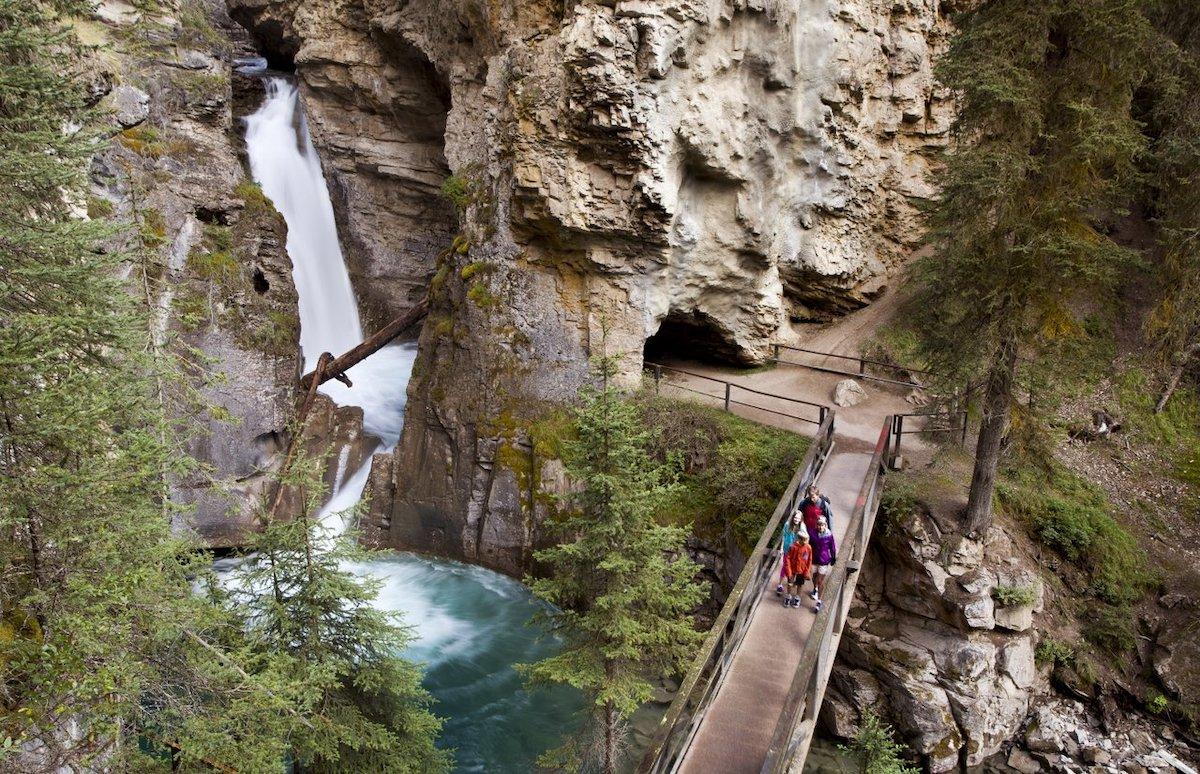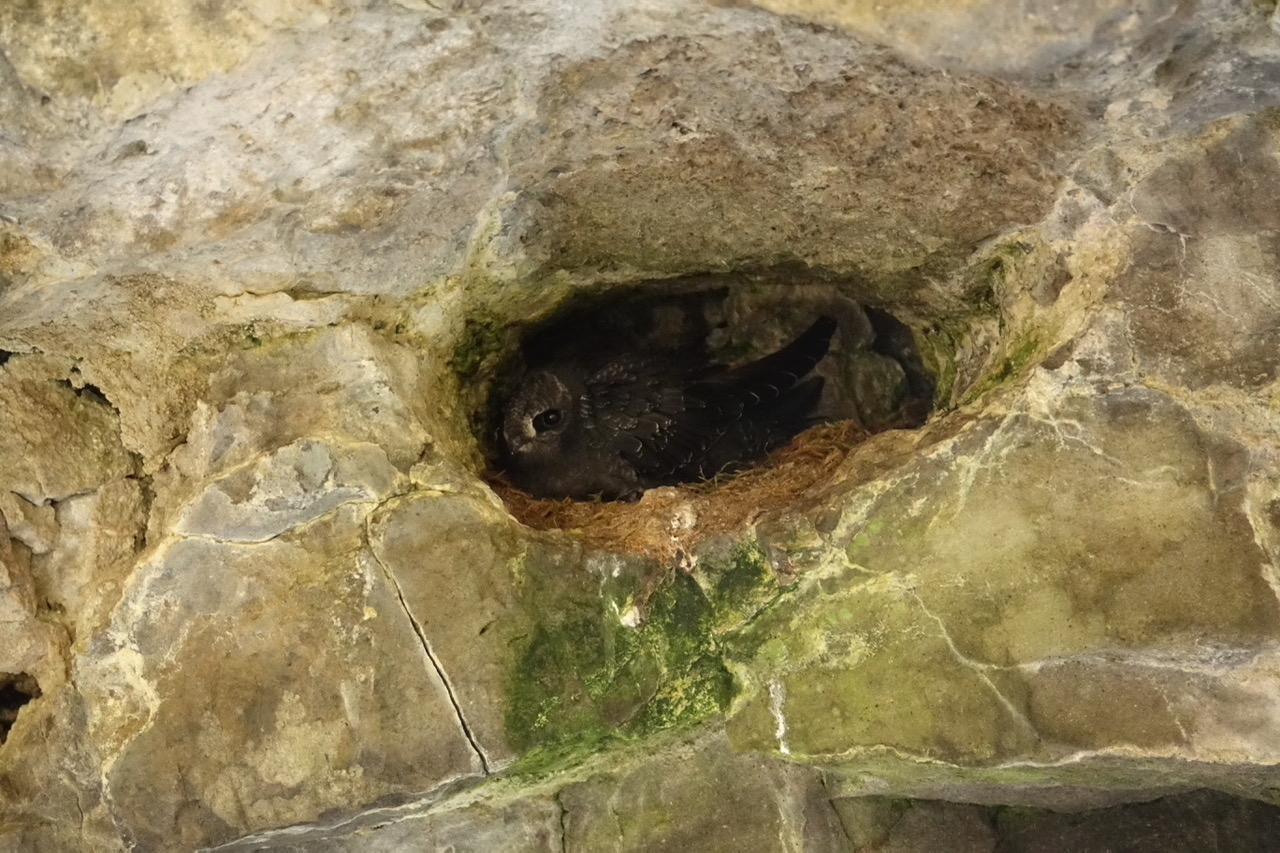Protecting Rare Birds On One Of Banff National Park’s Busiest Trails
By Carol Patterson
Black eyes stare from the shadows of a tiny cave, a feathered, white crescent drawing my gaze. I halt mid-step, my eyes probing the inky dimness of the cliffside cavern. I’m looking at one of Banff National Park’s rarest birds — the black swift — from one of its busiest hiking trails, Johnston Canyon.
The black swift is so specialized few people will see them. The bird, a bit more than 18.5 centimeters (7 inches) long, about the size of a bluebird, can’t perch. Instead, it clings to rock with its long, pointed wings tucked against its cigar-shaped body as they roost. For much of their life they fly, hunting insects, their only food source. The largest swift in North America, the sooty-coloured bird nests behind or near waterfalls, landscapes that often draw tourists in Canada’s first national park, and are vulnerable to disturbance.
Found from British Columbia and Alberta to Brazil, the first black swift in Alberta was spotted in Johnston Canyon in 1919 when few people visited the Banff area. The birds still return to the canyon, but their numbers often vary from year to year. Whether park visitation — the tally exceeds four million annually — affects the swift's decision to nest isn't fully known. But one of the most popular attractions in the Rockies, Johnston Canyon boasts two waterfalls, the first just over a kilometre (half a mile) from the trailhead, and it has been a canyon popular with the swifts that do return.
When Instagrammers posted pictures of a “secret” cave several years ago, it spawned copycat picture-takers pushing past trail barriers into swift habitat and raised concerns that the trespassers would reduce survival rates for a bird already on Canada’s endangered species list. “As soon as you put the word 'secret' somewhere, then everyone wants to find it,” laments Daniella Rubeling, the park’s visitor experience manager, adding that “a big piece of (our) communication is encouraging people to stay out of there.”
As I gaze across a metal railing and the emerald-coloured waters of Johnston Creek to the swift nest, I have no trouble identifying where I should be and where I shouldn’t. Wire cables delineate out-of-bounds area and signs warn of potential $25,000 fines (about $19,000 USD) for trespassing.

A warning sign and barrier prevents visitors from entering areas where black swifts are nesting in Banff National Park/Carol Patterson
“In 2019, there were 77 people charged under the National Parks Act for violating that restricted activity order, in 2020, 21 charges were laid,” explains Rubeling. Perhaps the decrease in charges was due to pandemic restrictions — in 2020 the Bow Valley Parkway access to the trailhead was closed to vehicle traffic — but some might be due to visitor education.
“Over the last few years, we’ve implemented a few different strategies, one of which was the restricted activity order that goes from May 1st to November 15th. There’s been increased signage to remind visitors to stay on the trail, increased monitoring in the closed area. We installed some temporary cable fencing to keep people to designated trail, and when possible increased staff presence in that area. Pre-COVID-19 our plans were to have interpretive staff there regularly,” says Rubeling.
Truly Rare Birds
Because these birds spend so much time in the air and nest in difficult-to-reach sites, black swifts have been slow to reveal their habits. The species wasn’t described by Western scientists until 1857 — it was one of the last North American birds to be identified. Until 2010, no one knew where they wintered (but then Colorado researchers attached geolocators to migrating birds and discovered three wintered in northwest Brazil) and no one is sure how many black swifts there are.
Partners in Flight, a network of 150 partner organizations in the Western Hemisphere, used data from breeding bird surveys to estimate 210,000 birds in the global population, but some researchers feel this count is high. The Committee on The Status of Endangered Wildlife in Canada (COSEWIC) estimated Canadian summer populations fall between 15,000 to 60,000 adult black swifts, representing perhaps as much as 81 percent of North American's black swift population. Most nest in British Columbia. COSEWIC estimated less than one-tenth of 1 percent of the North American population migrates to Alberta. More study is needed for an accurate count.

This black swift was spotted at Ouray Falls, Colorado/Sharon Forsyth
Historical records suggest the Johnston Canyon birds have never been common. Geoff Holroyd, a Canadian Wildlife Service scientist, told Birder’s World magazine (now BirdWatching) there were five nests in Johnston Canyon in 1976 and 1979, and 12 in 1981 and 1982. Ornithologist Jason Rogers, familiar with historical nest locations, located only one active nest in 2006 and 2007. In 2019 researchers found two active nests, but only one was successful.
Last year yielded some swift excitement. “For the 2020 season there were three nesting pairs at Johnston Canyon. All had successful fledglings,” confirms Jennifer Reimer, resource management officer and project lead for the black swift monitoring project in Banff. After discovering five more swifts last summer at Egypt Lake, a Banff National Park backcountry destination 18 kilometers (10 miles) south, Reimer suggests, “It’s possible (there are nests at other waterfall sites) but because they have such specific nesting requirements, we don’t suspect we’ll find a whole bunch of other nesting locations in Banff National Park.”

A view of Johnston Canyon in Banff National Park/Paul Zizka
There have been two nests observed in nearby Kootenay National Park in British Columbia and several in Alberta’s Jasper National Park, but it’s the conflicts between birds and people in Johnston Canyon that have made news headlines in the past two years. As to how to keep people from walking too close to swifts, Reimer believes “the more people get how sensitive swifts are, and how few birds we have, it just builds on fostering that stewardship so people feel they are contributing to the park (by following the rules).”
Riding To My Swift Encounter
At dawn, I climb on my bike and cycle 18 kilometers (11 miles) along the Bow Valley Parkway — closed to vehicles because of the pandemic — eager to hike a trail I usually avoid because of crowds. As my tires hum along the empty blacktop, I search each buffalo berry bush for bears, but this morning’s coast into the parking lot is bruin-free. Locking my bike up near the two-story wooden café, I watch red squirrels hoarding seeds for the approaching winter.
Now I soak in my first-ever encounter with a black swift. In birdwatcher parlance it’s a lifer, the first time I’ve ever seen this species. I bring my binoculars to my eyes and focus 10 meters (30 feet) away on the bird in the nest. Once this baby takes to the air, I’ll have trouble spotting it. It will fly for months at a time, migrating south and hunting insects, even sleeping in the air as half its brain rests, the other half active.
The creature is so still I stare for several seconds, my glasses fogging up in the cool air as I search for movement. It’s September 2 and a bird on the nest seems late. It is late. Perhaps it’s dead. I spotted flocks of warblers fleeing south two weeks earlier ahead of fall’s chill. But black swifts don’t do anything easily. They lay one egg, gambling their evolutionary success on a single hatchling, regurgitating insects like flying ants to feed swift junior.

Black swifts lay one egg in a nest near or behind a waterfall, like this one that the author saw in Banff National Park's Johnston Canyon/Carol Patterson
Partners in Flight estimates global black swift populations declined 94 percent between 1970 and 2014, placing the bird on the Yellow Watch List indicating it has small populations, declining numbers and habitat threats. COSEWIC classifies the species as endangered and suggested Canadian populations declined by more than 50 percent in four decades between 1973 and 2012. Researchers blame an increase in air pollutants that reduce insect populations, and climate change for reducing glacier and snow melt and the water flows near nest sites, and for disturbing the timing of flying ant hatches.
The fresh smell of fir touches my nostrils, a child’s squeal rises from below as spray from the falls dusts her face, and a breeze ripples the forest’s treetops, but I ignore it all, hoping this bird, so important to Canadian’s biodiversity, is still in the game. Slowly, the chick lifts its head, its eye catching the light before it nestles deeper into its moss and mud bed. It’s alive and I learn later, it fledged (left the nest) successfully.
I wander closer to the lower falls, a small gathering of people laugh and take photos, unaware the Canadian equivalent of a giant panda slumbers a few meters away. Parks Canada is working hard to understand these aerial specialists, better define their role in the ecosystem, and keep them secure. In addition to physical barriers and fines, they’ve asked bloggers, influencers, and websites to remove online references to the secret cave. They even created an animated video to help people understand a swift’s special needs, and hope to have more interpreters on the trail as the pandemic eases.
I amble back to my bike, content, knowing Banff protects this natural recluse.
Carol Patterson is a nature enthusiast and travel writer based in Calgary, Alberta. Read more of her work at CarolPatterson.ca.

 Support Essential Coverage of Essential Places
Support Essential Coverage of Essential Places




Comments
Thank you for this facinating well written article with useful conservation information. We have observed a recent uptick of irresponsible park visitor's behavior disturbing Yellowstone Wolves. Love to see more articles supporting respect for wildlife in Parks.